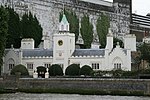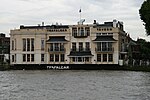Greenwich Power Station
Buildings and structures in the Royal Borough of GreenwichCoal-fired power stations in EnglandFormer power stations in LondonLondon Underground infrastructureNatural gas-fired power stations in England ... and 5 more
Oil-fired power stations in EnglandPort of LondonPower stations in LondonPower stations on the River ThamesUse British English from March 2014

Greenwich Power Station is a standby gas and formerly oil and coal-fired power station by the River Thames at Greenwich in south-east London. Originally constructed to supply power for London's tram system, since 1988 it has been London Underground's central emergency power supply, providing power if there is partial or total loss of National Grid supplies.
Excerpt from the Wikipedia article Greenwich Power Station (License: CC BY-SA 3.0, Authors, Images).Greenwich Power Station
Crowleys Wharf, London East Greenwich (Royal Borough of Greenwich)
Geographical coordinates (GPS) Address Nearby Places Show on map
Geographical coordinates (GPS)
| Latitude | Longitude |
|---|---|
| N 51.485 ° | E -0.001 ° |
Address
Greenwich Power Station
Crowleys Wharf
SE10 9UT London, East Greenwich (Royal Borough of Greenwich)
England, United Kingdom
Open on Google Maps








